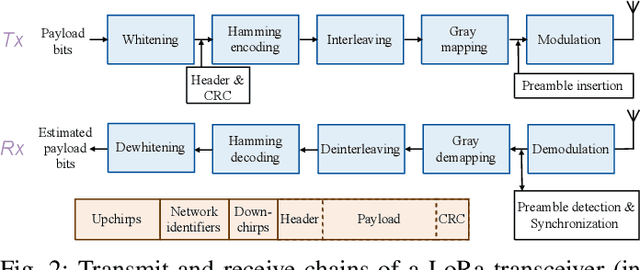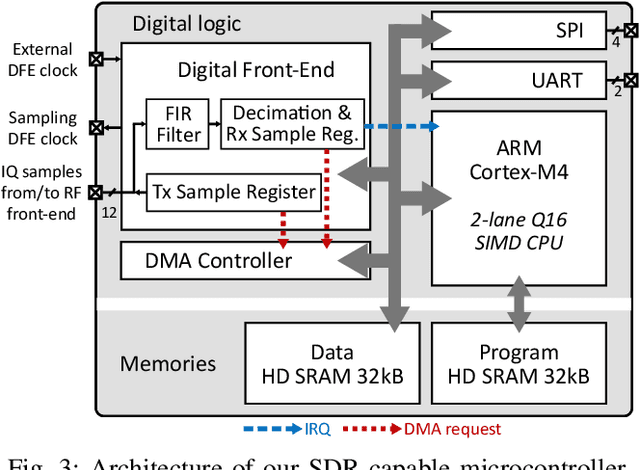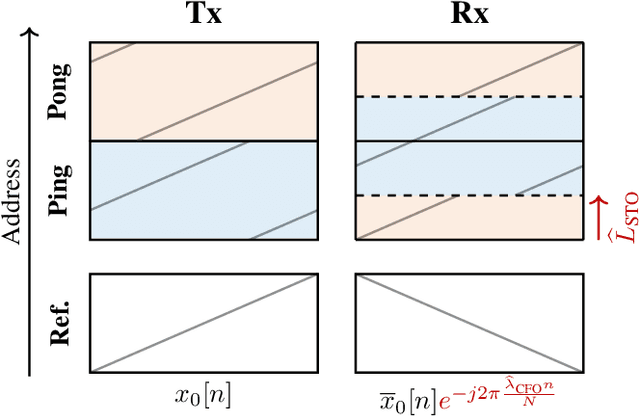Jérôme Louveaux
Hybrid Fusion for 802.11ax Wi-Fi-based Passive Radars Exploiting Beamforming Feedbacks
Apr 22, 2024Abstract:Passive Wi-Fi-based radars (PWRs) are devices that enable the localization of targets using Wi-Fi signals of opportunity transmitted by an access point. Unlike active radars that optimize their transmitted waveform for localization, PWRs align with the 802.11 amendments. Specifically, during the channel sounding session preceding a multi-user multiple-input multiple-output downlink transmission, an access point isotropically transmits a null data packet (NDP) with a known preamble. From these known symbols, client user equipments derive their channel state information and transmit an unencrypted beamforming feedback (BFF) back to the access point. The BFF comprises the right singular matrix of the channel and the corresponding stream gain for each subcarrier, which allows the computation of a beamforming matrix at the access point. In a classical PWR processing, only the preamble symbols from the NDP are exploited during the channel sounding session. In this study, we investigate multiple target localization by a PWR exploiting hybrid information sources. On one hand, the joint angle-of-departure and angle-of-arrival evaluated from the NDP. On another hand, the line-of-sight angle-of-departures inferred from the BFFs. The processing steps at the PWR are defined and an optimal hybrid fusion rule is derived in the maximum likelihood framework. Monte-Carlo simulations assess the enhanced accuracy of the proposed combination method compared to classical PWR processing based solely on the NDP, and compare the localisation performance between client and non-client targets.
Maximum Likelihood Alternating Summation for Multistatic Angle-based Multitarget Localization
Mar 20, 2024Abstract:Recent advancements in Wi-Fi sensing have sparked interest in exploiting OFDM modulated communication signals for target detection and tracking. In this study, we address the angle-based localization of multiple targets using a multistatic OFDM radar. While the maximum likelihood approach optimally merges data from each radar pair comprised by the system, it entails a complex multi-dimensional search process. Leveraging pre-estimation of the targets' parameters obtained via the MUSIC algorithm, our method decouples this multi-dimensional search into a single two-dimensional estimator per target. The proposed alternating summation method allows the computation of a combined likelihood map aggregating contributions from each radar pair, enabling target detection via peak selection. Besides reducing computational complexity, the method effectively captures target interactions and accommodates varying radar pair localization abilities. Also, it requires transmitting only the estimated channel covariance matrices of each radar pair to the central processor. Numerical simulations demonstrate superior performance over existing approaches.
Cellular Load Dependent Sleep Control for Energy Efficient HetNets with Non-Uniform User Distributions
Feb 22, 2024Abstract:This study proposes a novel stochastic geometry framework analyzing power control strategies in spatially correlated network topologies. Heterogeneous networks are studied, with users modeled via the superposition of homogeneous and Poisson cluster processes. First, a new expression approaching the distribution of the number of users per base station is provided. This distribution defines the load associated with each Vorono\"i cell, capturing non-uniformities in user locations and correlation to BSs positions. The power allocation is adjusted based on this load, allowing BSs to enter sleep mode when their activity falls below a defined threshold. Furthermore, the propagation model features millimeter wave transmission characteristics and directional beamforming. Considering these aspects, revisited definitions of coverage probability, spectral efficiency, and energy efficiency are proposed. Tractable expressions for these metrics are derived and validated using Monte-Carlo simulations. Asymptotic expressions are also proposed, providing further understanding on the influence of the system parameters. Our numerical results finally analyze the impact of the sleep control on the performance and display the optimal strategies in terms of energy efficiency.
Multistatic OFDM Radar Fusion of MUSIC-based Angle Estimation
Feb 20, 2024Abstract:This study investigates the problem of angle-based localization of multiple targets using a multistatic OFDM radar. Although the maximum likelihood (ML) approach can be employed to merge data from different radar pairs, this method requires a high complexity multi-dimensional search process. The multiple signal classification (MUSIC) algorithm simplifies the complexity to a two-dimensional search, but no framework is derived for combining MUSIC pseudo-spectrums in a multistatic configuration. This paper exploits the relationship between MUSIC and ML estimators to approximate the multidimensional ML parameter estimation with a weighted combination of MUSIC pseudo-spectrum. This enables the computation of a likelihood map on which a peak selection is applied for target detection. In addition to reducing the computational complexity, the proposed method relies only on transmitting the estimated channel covariance matrices of each radar pair to the central processor. A numerical analysis is conducted to assess the benefits of the proposed fusion.
Implementing a LoRa Software-Defined Radio on a General-Purpose ULP Microcontroller
Jul 17, 2021



Abstract:Emerging Internet-of-Things sensing applications rely on ultra low-power (ULP) microcontroller units (MCUs) that wirelessly transmit data to the cloud. Typical MCUs nowadays consist of generic blocks, except for the protocol-specific radios implemented in hardware. Hardware radios however slow down the evolution of wireless protocols due to retrocompatiblity concerns. In this work, we explore a software-defined radio architecture by demonstrating a LoRa transceiver running on custom ULP MCU codenamed SleepRider with an ARM Cortex-M4 CPU. In SleepRider MCU, we offload the generic baseband operations (e.g., low-pass filtering) to a reconfigurable digital front-end block and use the Cortex-M4 CPU to perform the protocol-specific computations. Our software implementation of the LoRa physical layer only uses the native SIMD instructions of the Cortex-M4 to achieve real-time transmission and reception of LoRa packets. SleepRider MCU has been fabricated in a 28nm FDSOI CMOS technology and is used in a testbed to experimentally validate the software implementation. Experimental results show that the proposed software-defined radio requires only a CPU frequency of 20 MHz to correctly receive a LoRa packet, with an ultra-low power consumption of 0.42 mW on average.
 Add to Chrome
Add to Chrome Add to Firefox
Add to Firefox Add to Edge
Add to Edge